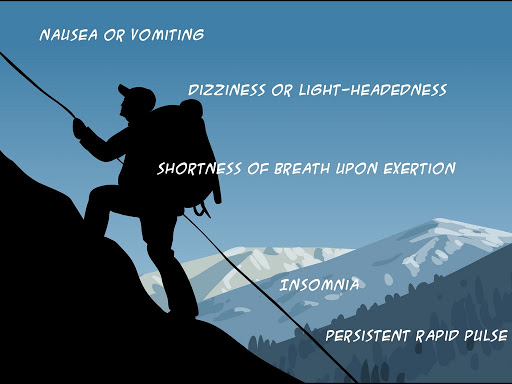The Northern Areas of Pakistan have a history of tourism and mountaineering. K2 , Broad Peak, Nanga Parbat, Gasherbrum I and Gasherbrum II are five of the 14 peaks in the world over 8,000 meters and are all internationally renowned mountaineering challenges. Most of the highest mountains in Pakistan are located in the Karakoram range, but some high mountains are in Himalaya (the highest of which is Nanga Parbat, globally ranked 9th, 8126 m) and Hindu Kush (the highest of which is Tirich Mir, globally ranked 33rd, 7708 m).
Acute mountain sickness (AMS), also known as altitude illness, is a common malady above 2,400 m (8,000 ft), especially if you do not have a chance to acclimatize by ascending gradually. Do not be surprised if you get altitude sickness traveling the roads of northern Pakistan as the average altitude is at least 2,000m. The prevalence of AMS varies between 15% and 75%, depending on your speed of ascent, altitude gained, sleeping altitude, and individual susceptibility.
Acute mountain sickness can progress to high altitude cerebral edema (HACE) or be associated with high altitude pulmonary edema (HAPE). You should intersperse your ascent with rest days and avoid, if possible, increasing your sleeping altitude by more than 1,000 – 1,500 feet each night. To reduce further your risk of AMS, take acetazolamide (Diamox), starting the day prior to beginning your ascent.
Acetazolamide is a respiratory stimulant that speeds acclimatization and is about 75% effective. It may also reduce the risk of HAPE.
- Symptoms of AMS include mild to moderate headache, loss of appetite, nausea, fatigue, dizziness and insomnia. Mild AMS usually resolves with rest plus medication for headache and nausea. You can also take acetazolamide to treat mild AMS.
- Under no circumstances should you continue to ascend (especially to a higher sleeping altitude) if you have any persistent symptoms of altitude illness. In the absence of improvement or with progression of symptoms you should descend (at least 500 m) to a lower altitude.
- Dexamethasone (Decadron) is a steroid drug used for treating AMS and HACE. You should carry stand-by treatment doses. You can take dexamethasone together with acetazolamide to treat mild- to moderate-AMS.
- More severe AMS (increasing headache, vomiting, increasing fatigue or lethargy) may indicate the incipient onset of high-altitude cerebral edema (HACE)—recognized by confusion, difficulty with balance and coordination, staggering gait. Start treatment with dexamethasone and descend immediately.
- Increasing dry cough and breathlessness at rest may indicate high altitude pulmonary edema (HAPE). Nifedipine, sildenafil (Viagra), or tadalafil (Cialis) can be used for both the prevention and treatment of HAPE. Dexamethasone and the asthma drug salmeterol (Serevent) also will prevent HAPE.
- Descent, combined with medication (and oxygen, if available) is the best treatment for more severe AMS, HACE or HAPE. Consider helicopter evacuation if the situation is urgent.
Caution: Prior to departing for a high-altitude trip, consult with a physician about the use of medications for preventing/treating altitude illness.


Leave a Reply